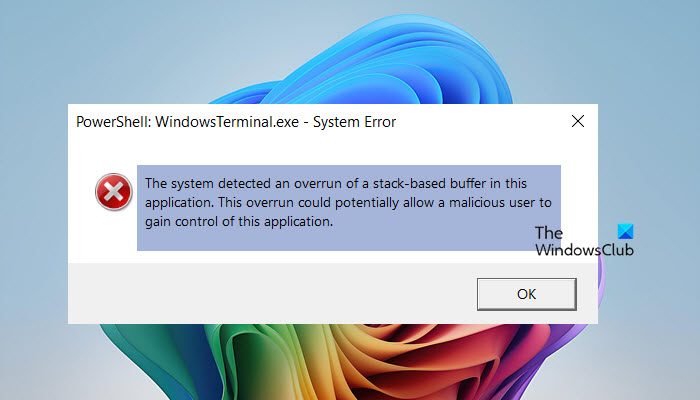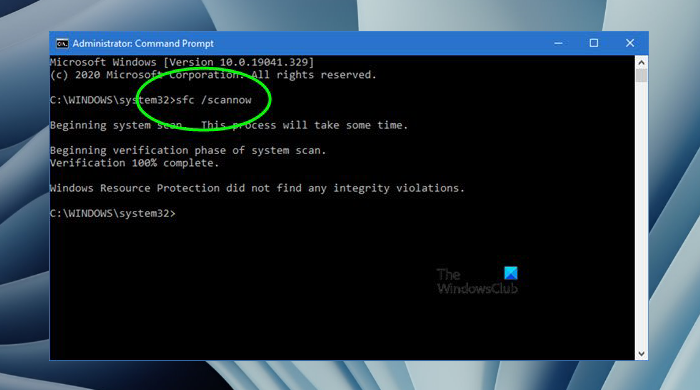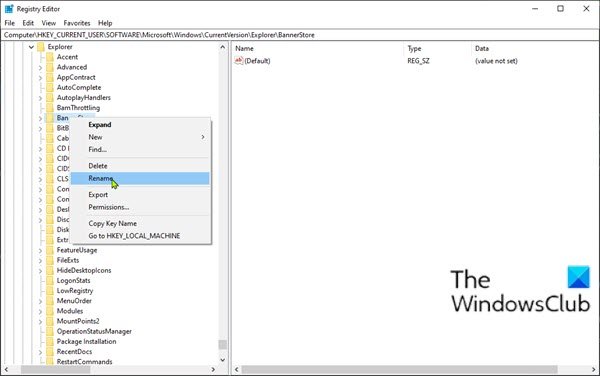If you encounter the error message “The system detected an overrun of a stack-based buffer in this application” when trying to run an application on your Windows 11/10 computer or attempting to boot into Safe Mode, this guide is here to help. We will provide suitable solutions to resolve this issue.

When you encounter this issue. you’ll receive the following full error message;
Error
The system detected an overrun of a stack-based buffer in this application. This overrun could potentially allow a malicious user to gain control of this application.
Stack-based buffer overrun (or stack-based buffer overflow) is a bug that indicates that a program writes more data to a buffer located on the stack than is actually allocated for the buffer. It is a general programming malfunction. The error is known to occur for the sihost.exe (Shell Infrastructure Host) file.
This issue might happen to your driver and lead to the DRIVER OVERRAN STACK BUFFER Blue Screen error. But more commonly, it’s related to your applications, and once it comes up, the adjacent data on the stack might be corrupted and the program is likely to crash or operate improperly.
The system detected an overrun of a stack-based buffer in this application
If you’re faced with this issue, you can try our recommended solutions below in no particular order and see if that helps to resolve the issue. Before you begin, reinstall or reset the application that is giving this error and see if it helps.
- Scan for malware/virus infection
- Run SFC and DISM scan
- Troubleshoot in Clean Boot state
- Modify the BannerStore registry key
- Run Memory test
- Perform System Restore.
Let’s take a look at the description of the process involved concerning each of the listed solutions.
1] Scan for malware/virus infection
Based on the error prompt shown above, Windows indicates that a certain application allows meddling with code (stack smashing) which allows injecting malicious code into your application. So, scanning for malware/virus with Windows Defender or any reputable third-party AV product is a logical step. Of course, if you’re unable to boot, you can try with the Safe Mode and run Windows Defender Offline Scan at boot time or use bootable AntiVirus Rescue Media to remove all threats and recover your system.
2] Run SFC and DISM scan

For this solution, you’ll need the Safe Mode with Networking as Deployment Image Servicing and Management (DISM) utility requires an internet connection as it attempts to fix corrupted system files from Windows Update.
On the other hand, the System File Checker (SFC) doesn’t require an internet connection as it attempts to fix corrupted system files from the Windows Component Store. However, we’ll need to run both tools to fix possible system corruption. These two Windows 11/10 native utilities work best when combined.
So, to run SFC/DISM scan in tandem, do the following:
- Press Windows key + R to invoke the Run dialog.
- In the Run dialog box, type
notepadand hit Enter to open Notepad. - Copy and paste the syntax below into the text editor.
@echo off date /t & time /t echo Dism /Online /Cleanup-Image /StartComponentCleanup Dism /Online /Cleanup-Image /StartComponentCleanup echo ... date /t & time /t echo Dism /Online /Cleanup-Image /RestoreHealth Dism /Online /Cleanup-Image /RestoreHealth echo ... date /t & time /t echo SFC /scannow SFC /scannow date /t & time /t pause
- Save the file with a name and append the .bat file extension – eg; SFC_DISM_scan.bat on the Save as type box select All Files.
- Repeatedly run the batch file with admin privilege (right-click the saved file and select Run as Administrator from the context menu) until it reports no errors.
- Restart your PC.
On boot, see if the issue is resolved. If not proceed with the next solution.
3] Troubleshoot in Clean Boot state
If you notice that Windows 11/10 isn’t operating properly, or if an official Windows 11/10 update won’t install properly, it’s always a good idea to check for any conflicts. By booting into Clean booting Windows, you should be able to root out the culprit and make necessary changes.
In this solution, you can troubleshoot in the Clean Boot state and see if The system detected an overrun of a stack-based buffer in this application error can be resolved.
4] Modify the BannerStore registry key

Since this is a registry operation, it is recommended that you back up the registry or create a system restore point as necessary precautionary measures. Once done, you can proceed as follows:
- Press the Windows key + R to invoke the Run dialog.
- In the Run dialog box, type
regeditand hit Enter to open Registry Editor. - Navigate or jump to the registry key path below:
HKEY_CURRENT_USER\Software\Microsoft\Windows\CurrentVersion\Explorer
- At the location, on the left pane, locate the BannerStore registry key folder.
- Right-click the folder, then select Rename and rename it to BannerStoreOld.
- Now, press the Ctrl+Alt+Delete combo on your keyboard to access security options.
- Click on Sign Out to sign out from your computer.
- Sign back in.
The issue should be resolved. If not, try the next solution.
5] Scan for memory issues
Corruption in RAM can potentially make Windows unstable and thus trigger Blue Screen Of Death errors. So if you added a new RAM stick, remove it and check if that is causing the error. If not, then you need to run a memory test. Windows will initiate checking for abnormalities in RAM. If it finds any, you need to replace the affected RAM.
6] Perform System Restore
If you have exhausted the above solutions but the issue is still unresolved, you can try System Restore. The procedure will revert (without affecting your personal files) your Windows 11/10 system to an earlier point in time (you specify) prior to the start of the issue.
Hope this helps!
Related error: SystemSettings.exe System Error, The system detected an overrun of a stack-based buffer in this application. This overrun could potentially allow a malicious user to gain control of this application.
What does Buffer overrun detected mean?
When the data volume surpasses the memory buffer’s storage capacity, you will see a “Buffer overrun” or “Buffer overflow” error message. Therefore, if a program is trying to write data to bugger, it can either terminate the session or move to the adjacent block.
Also Read: What is Buffer Overflow Attack?.